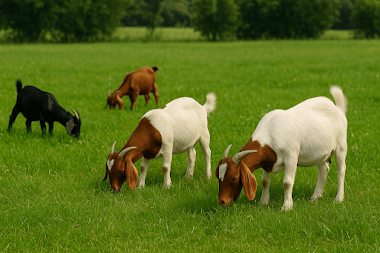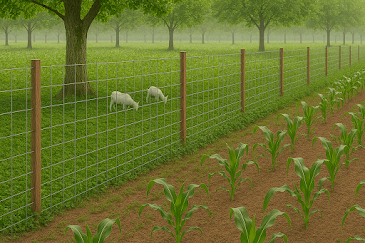Profitable, Goat Farming, for Beginners | Raising Goats, its Types, and overall Management.|
Goat Farming is a Profitable Livestock Venture for environmentally friendly Agriculture. One of the most sustainable and Profitable Animal Farming practices is Goat Farming. With increasing demand for goat meat (chevon), milk, fiber, and skin, Raising Goats is a low-investment, high-return Livestock activity suitable for rural and semi-urban farmers. This guide covers everything you need to know as a Beginner about starting and succeeding in Goat Farming, whether you are a smallholder or a commercial entrepreneur.
Why Goat Farming?
• Low investment: Compared to poultry or cattle, it requires less money.
• High Rate of Reproduction: A goat can conceive twice a year, most frequently with twins or triplets.
• Multifunctional: Provides meat, milk, leather, manure, and even fiber (in breeds like Angora and Cashmere).
• Minimal Space Requirement: Goats need less housing space, making them ideal for small farms.
• Strong Demand in the Market: Because of its flavor and leanness, goat meat is highly prized in many cultures.
Types of Goat Farming Systems
Goat farming can be done in a variety of ways, depending on your resources, climate, and size:
1. Comprehensive System
• Goats are allowed to graze freely on natural vegetation.
• Low productivity due to low inputs.
• Common in tribal and remote regions.
2. Semi-Intensive System
• Balanced system for mid-size farms.
• Ensures better nutrition and productivity.
3. Intensive System
• Complete stall-feeding with controlled environment.
• High investment, high yield.
• Suitable for commercial goat farming operations.
Raising Goats/Breed Selection

Choosing the right goat breed depends on your purpose i.e, meat, milk, or dual-purpose. Below are some of the best breeds:
| Breed | Purpose | Origin | Feature |
|---|---|---|---|
| Boer | Meat | South Africa | Rapid expansion and high meat yield |
| Sirohi | Dual-purpose | India | Hardy, suitable for hot climates |
| Jamunapari | Milk | India | Large body size and high milk yield |
| Black Bengal | Meat | Bangladesh | Early maturity, fine meat quality |
| Beetal | Milk/Meat | India/Pakistan | Dual-purpose, adaptable to stall-feeding |
| Barbari | Dual-purpose | India/Pakistan | Small size, high fertility, ideal for dual-purpose farming |
Goat Shelter and Housing
Proper housing ensures safety, health, and productivity of your goats. Here are key points:
• Ventilation: Goats are prone to respiratory diseases. Provide good air flow.
• Dry Flooring: Use raised bamboo or wooden floors to avoid hoof rot.
• Space: Allow 10 sq. feet per adult goat.
• Cleanliness: To avoid infections and parasites, regularly clean the housing.
• Fencing: Strong fencing prevents escape and protects from predators.
Feed and Nutrition in Goat Farming
Goats are natural browsers. They eat a variety of shrubs, leaves, herbs, and grains. Growth and fertility are boosted by eating in a healthy way.
Important Feed Components:
• Green fodder: Subabul, Lucerne, and Napier grass serve as green fodder.
• Dry Fodder: Hay, groundnut husk, wheat straw.
• Concentrates: oilseed cakes, maize bran, and other grains
• Minerals & Salt: Provide a mineral mix and salt lick to avoid deficiencies.
• Water: Always provide fresh, clean water.
Tip: Pregnant and lactating does need extra protein and energy.
Goat Health and Disease Management
Common Goat Diseases
| Disease | Symptoms | Prevention |
|---|---|---|
| PPR (Plague) | Fever, diarrhea, nasal discharge | Vaccinate at 3 months of age |
| Foot Rot | Limping, swelling | Keep floors dry and trim hooves |
| Enterotoxemia | Sudden death, swelling, and bloating | Vaccination |
| Ectoparasites | Itching, skin lesions | Deworm and use medicated dips |
Additional Advice:
Deworm every three to four months and vaccinate according to local veterinary recommendations.
Breeding and Reproduction
• Ratio: 1 buck for 25 does.
• Breeding Cycle: Every 8 months.
• Gestation Period: ~150 days (5 months).
• Joking: Usually triplets or twins.
Kids should be fed colostrum (first milk) within 2 hours of birth for strong immunity.
Marketing of Goat Products
1. Meat from Goats (Chevon)
• Highly demanded during festivals and weddings.
• Can be sold directly to local butchers, restaurants, or meat shops.
2. Goat Milk
• Easier to digest than cow’s milk.
• Used to make soap, cheese, and yogurt.
3. Live Goats
• Sold for breeding, sacrifice, or as pets.
• Value is influenced by age, weight, and breed.
4. Manure
• Goat droppings are rich in nutrients and used as organic fertilizer.
tip: Using online platforms or forming a cooperative can help you reach more customers.
Integrating Goat Farming with Other Systems
• Fish + Goat: Goat manure boosts algae growth in fish ponds.
• Crop + Goat: Goats feed on crop residues; manure returns nutrients to the soil.
Conclusion:
Raising Goats can make a lot of money in a short amount of time and can be very Profitable, if you plan well, choose the right breed, and manage the animals in a scientific way. It provides a steady income, particularly for rural women, young entrepreneurs, and small farmers.
Build your farm step by step, no matter how many goats you start with. Your Goat Farming will soon become a successful business if you concentrate on animal health, housing, and market access.
Frequently Asked Questions
Common Questions Concerning Goat Farming
1. Is beginning goat farming profitable?
Yes,
goat farming is highly profitable due to low investment, fast reproduction, and
strong market demand for meat, milk, and manure.
2.What is the best breed for goat meat production?
Boer goats are ideal for meat due to their fast growth and high carcass yield, but local breeds like Black Bengal also perform well.
3. How many goats can I start with on a small farm?
You can start with as few as 5 does and 1 buck, especially in a semi-intensive setup with good fodder and shelter.
4. What do goats eat daily?
A balanced diet includes green fodder, dry roughage, grains, minerals, and constant access to clean water.
5. Is it possible to combine goat farming with other activities?
Yes, goat farming can be integrated with fish farming, cropping, or agroforestry to maximize farm efficiency and profit.
For more information on different kinds of Animal Farming, visit our Home page.












.png)






0 Comments